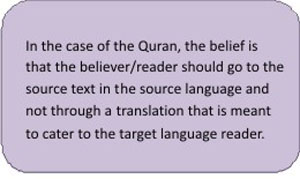Translation of the Quran
This reveals the pitfalls of translation, an aspect that you have to be doubly caref ul about when translating texts that are considered to be divine revelations. This also explains why most religions are extremely reluctant, if not prohibitory, about translation of scriptural texts. The Quran which is the sacred text of Islam, is similarly considered to be outside the pale of translation. According to Hassan Mustapha, “The importance attached to the Quran stems from the belief that it contains, verbatim, the Word of God, as revealed piecemeal to Muhammad by the Angel Gabriel between 610 and 632 AD. It is therefore considered inimitable, and this has important implications for both the legitimacy and the (authorized) methods of translating it” (“Quran Translation”, 200). The traditional belief is that it is wrong to translate the Quran. It has a language that is specific to it; the Arabic of the Quran is different from the Arabic that is used by native speakers. So whoever wishes to read the Holy Book is supposed to master the language in which it is written. The text cannot, or should not be rendered into a language to cater to the target readership. ul about when translating texts that are considered to be divine revelations. This also explains why most religions are extremely reluctant, if not prohibitory, about translation of scriptural texts. The Quran which is the sacred text of Islam, is similarly considered to be outside the pale of translation. According to Hassan Mustapha, “The importance attached to the Quran stems from the belief that it contains, verbatim, the Word of God, as revealed piecemeal to Muhammad by the Angel Gabriel between 610 and 632 AD. It is therefore considered inimitable, and this has important implications for both the legitimacy and the (authorized) methods of translating it” (“Quran Translation”, 200). The traditional belief is that it is wrong to translate the Quran. It has a language that is specific to it; the Arabic of the Quran is different from the Arabic that is used by native speakers. So whoever wishes to read the Holy Book is supposed to master the language in which it is written. The text cannot, or should not be rendered into a language to cater to the target readership.
The Quran was originally meant to be recited and was composed in rhyming prose. The canonical text was written down under the direction of the third Caliph Uthman ibn Affan in the 7th century. This was sent to various cities with the express orders that all other unauthorized versions be destroyed. Hassan Mustapha notes that “there are seven legitimate readings (ahruf) in circulation, which differ mainly in the manner in which the verses are recited orally and the interplay between the recited and written forms” (200). Besides the written language, a lot of importance is given to the way in which the verses are recited for which it is imperative to have a good grasp of pronunciation and intonation of the spoken language. |